Kang Zhao
Wan: Open and Advanced Large-Scale Video Generative Models
Mar 26, 2025Abstract:This report presents Wan, a comprehensive and open suite of video foundation models designed to push the boundaries of video generation. Built upon the mainstream diffusion transformer paradigm, Wan achieves significant advancements in generative capabilities through a series of innovations, including our novel VAE, scalable pre-training strategies, large-scale data curation, and automated evaluation metrics. These contributions collectively enhance the model's performance and versatility. Specifically, Wan is characterized by four key features: Leading Performance: The 14B model of Wan, trained on a vast dataset comprising billions of images and videos, demonstrates the scaling laws of video generation with respect to both data and model size. It consistently outperforms the existing open-source models as well as state-of-the-art commercial solutions across multiple internal and external benchmarks, demonstrating a clear and significant performance superiority. Comprehensiveness: Wan offers two capable models, i.e., 1.3B and 14B parameters, for efficiency and effectiveness respectively. It also covers multiple downstream applications, including image-to-video, instruction-guided video editing, and personal video generation, encompassing up to eight tasks. Consumer-Grade Efficiency: The 1.3B model demonstrates exceptional resource efficiency, requiring only 8.19 GB VRAM, making it compatible with a wide range of consumer-grade GPUs. Openness: We open-source the entire series of Wan, including source code and all models, with the goal of fostering the growth of the video generation community. This openness seeks to significantly expand the creative possibilities of video production in the industry and provide academia with high-quality video foundation models. All the code and models are available at https://github.com/Wan-Video/Wan2.1.
EgoVid-5M: A Large-Scale Video-Action Dataset for Egocentric Video Generation
Nov 13, 2024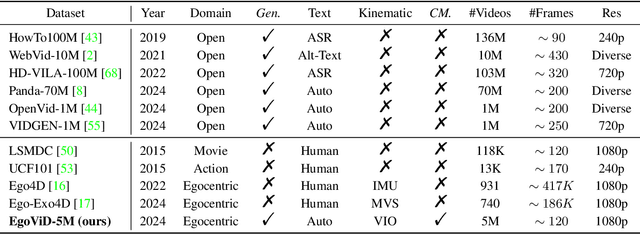
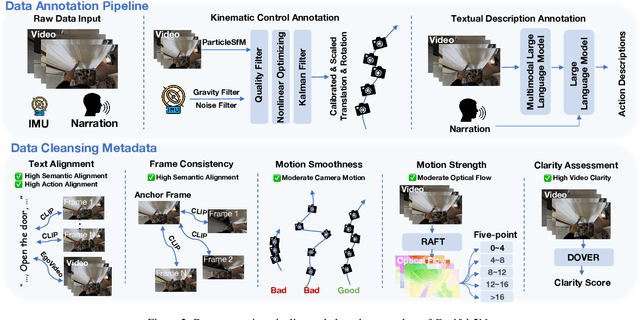

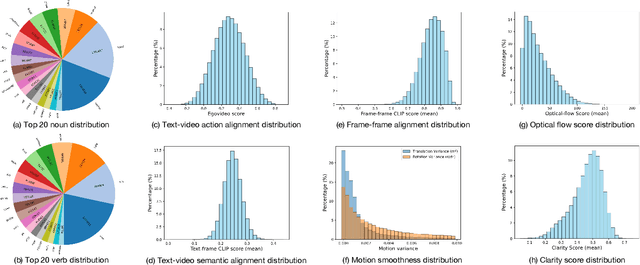
Abstract:Video generation has emerged as a promising tool for world simulation, leveraging visual data to replicate real-world environments. Within this context, egocentric video generation, which centers on the human perspective, holds significant potential for enhancing applications in virtual reality, augmented reality, and gaming. However, the generation of egocentric videos presents substantial challenges due to the dynamic nature of egocentric viewpoints, the intricate diversity of actions, and the complex variety of scenes encountered. Existing datasets are inadequate for addressing these challenges effectively. To bridge this gap, we present EgoVid-5M, the first high-quality dataset specifically curated for egocentric video generation. EgoVid-5M encompasses 5 million egocentric video clips and is enriched with detailed action annotations, including fine-grained kinematic control and high-level textual descriptions. To ensure the integrity and usability of the dataset, we implement a sophisticated data cleaning pipeline designed to maintain frame consistency, action coherence, and motion smoothness under egocentric conditions. Furthermore, we introduce EgoDreamer, which is capable of generating egocentric videos driven simultaneously by action descriptions and kinematic control signals. The EgoVid-5M dataset, associated action annotations, and all data cleansing metadata will be released for the advancement of research in egocentric video generation.
FastAttention: Extend FlashAttention2 to NPUs and Low-resource GPUs
Oct 22, 2024Abstract:FlashAttention series has been widely applied in the inference of large language models (LLMs). However, FlashAttention series only supports the high-level GPU architectures, e.g., Ampere and Hopper. At present, FlashAttention series is not easily transferrable to NPUs and low-resource GPUs. Moreover, FlashAttention series is inefficient for multi- NPUs or GPUs inference scenarios. In this work, we propose FastAttention which pioneers the adaptation of FlashAttention series for NPUs and low-resource GPUs to boost LLM inference efficiency. Specifically, we take Ascend NPUs and Volta-based GPUs as representatives for designing our FastAttention. We migrate FlashAttention series to Ascend NPUs by proposing a novel two-level tiling strategy for runtime speedup, tiling-mask strategy for memory saving and the tiling-AllReduce strategy for reducing communication overhead, respectively. Besides, we adapt FlashAttention for Volta-based GPUs by redesigning the operands layout in shared memory and introducing a simple yet effective CPU-GPU cooperative strategy for efficient memory utilization. On Ascend NPUs, our FastAttention can achieve a 10.7$\times$ speedup compared to the standard attention implementation. Llama-7B within FastAttention reaches up to 5.16$\times$ higher throughput than within the standard attention. On Volta architecture GPUs, FastAttention yields 1.43$\times$ speedup compared to its equivalents in \texttt{xformers}. Pangu-38B within FastAttention brings 1.46$\times$ end-to-end speedup using FasterTransformer. Coupled with the propose CPU-GPU cooperative strategy, FastAttention supports a maximal input length of 256K on 8 V100 GPUs. All the codes will be made available soon.
Beyond 2:4: exploring V:N:M sparsity for efficient transformer inference on GPUs
Oct 21, 2024



Abstract:To date, 2:4 sparsity has stood as the only sparse pattern that can be accelerated using sparse tensor cores on GPUs. In practice, 2:4 sparsity often possesses low actual speedups ($\leq 1.3$) and requires fixed sparse ratios, meaning that other ratios, such as 4:8, 8:16, or those exceeding 50% sparsity, do not incur any speedups on GPUs. Recent studies suggest that V:N:M sparsity is promising in addressing these limitations of 2:4 sparsity. However, regarding accuracy, the effects of V:N:M sparsity on broader Transformer models, such as vision Transformers and large language models (LLMs), are largely unexamined. Moreover, Some specific issues related to V:N:M sparsity, such as how to select appropriate V and M values, remain unresolved. In this study, we thoroughly investigate the application of V:N:M sparsity in vision models and LLMs across multiple tasks, from pertaining to downstream tasks. We propose three key approaches to enhance the applicability and accuracy of V:N:M-sparse Transformers, including heuristic V and M selection, V:N:M-specific channel permutation, and three-staged LoRA training techniques. Experimental results show that, with our methods, the DeiT-small achieves lossless accuracy at 64:2:5 sparsity, while the DeiT-base maintains accuracy even at 64:2:8 sparsity. In addition, the fine-tuned LLama2-7B at 64:2:5 sparsity performs comparably or better than training-free 2:4 sparse alternatives on downstream tasks. More importantly, V:N:M-sparse Transformers offer a wider range of speedup-accuracy trade-offs compared to 2:4 sparsity. Overall, our exploration largely facilitates the V:N:M sparsity to act as a truly effective acceleration solution for Transformers in cost-sensitive inference scenarios.
FlatQuant: Flatness Matters for LLM Quantization
Oct 12, 2024



Abstract:Recently, quantization has been widely used for the compression and acceleration of large language models~(LLMs). Due to the outliers in LLMs, it is crucial to flatten weights and activations to minimize quantization error with the equally spaced quantization points. Prior research explores various pre-quantization transformations to suppress outliers, such as per-channel scaling and Hadamard transformation. However, we observe that these transformed weights and activations can still remain steep and outspread. In this paper, we propose FlatQuant (Fast and Learnable Affine Transformation), a new post-training quantization approach to enhance flatness of weights and activations. Our approach identifies optimal affine transformations tailored to each linear layer, calibrated in hours via a lightweight objective. To reduce runtime overhead, we apply Kronecker decomposition to the transformation matrices, and fuse all operations in FlatQuant into a single kernel. Extensive experiments show that FlatQuant sets up a new state-of-the-art quantization benchmark. For instance, it achieves less than $\textbf{1}\%$ accuracy drop for W4A4 quantization on the LLaMA-3-70B model, surpassing SpinQuant by $\textbf{7.5}\%$. For inference latency, FlatQuant reduces the slowdown induced by pre-quantization transformation from 0.26x of QuaRot to merely $\textbf{0.07x}$, bringing up to $\textbf{2.3x}$ speedup for prefill and $\textbf{1.7x}$ speedup for decoding, respectively. Code is available at: \url{https://github.com/ruikangliu/FlatQuant}.
FreeMask: Rethinking the Importance of Attention Masks for Zero-Shot Video Editing
Sep 30, 2024



Abstract:Text-to-video diffusion models have made remarkable advancements. Driven by their ability to generate temporally coherent videos, research on zero-shot video editing using these fundamental models has expanded rapidly. To enhance editing quality, structural controls are frequently employed in video editing. Among these techniques, cross-attention mask control stands out for its effectiveness and efficiency. However, when cross-attention masks are naively applied to video editing, they can introduce artifacts such as blurring and flickering. Our experiments uncover a critical factor overlooked in previous video editing research: cross-attention masks are not consistently clear but vary with model structure and denoising timestep. To address this issue, we propose the metric Mask Matching Cost (MMC) that quantifies this variability and propose FreeMask, a method for selecting optimal masks tailored to specific video editing tasks. Using MMC-selected masks, we further improve the masked fusion mechanism within comprehensive attention features, e.g., temp, cross, and self-attention modules. Our approach can be seamlessly integrated into existing zero-shot video editing frameworks with better performance, requiring no control assistance or parameter fine-tuning but enabling adaptive decoupling of unedited semantic layouts with mask precision control. Extensive experiments demonstrate that FreeMask achieves superior semantic fidelity, temporal consistency, and editing quality compared to state-of-the-art methods.
1-Bit FQT: Pushing the Limit of Fully Quantized Training to 1-bit
Aug 26, 2024



Abstract:Fully quantized training (FQT) accelerates the training of deep neural networks by quantizing the activations, weights, and gradients into lower precision. To explore the ultimate limit of FQT (the lowest achievable precision), we make a first attempt to 1-bit FQT. We provide a theoretical analysis of FQT based on Adam and SGD, revealing that the gradient variance influences the convergence of FQT. Building on these theoretical results, we introduce an Activation Gradient Pruning (AGP) strategy. The strategy leverages the heterogeneity of gradients by pruning less informative gradients and enhancing the numerical precision of remaining gradients to mitigate gradient variance. Additionally, we propose Sample Channel joint Quantization (SCQ), which utilizes different quantization strategies in the computation of weight gradients and activation gradients to ensure that the method is friendly to low-bitwidth hardware. Finally, we present a framework to deploy our algorithm. For fine-tuning VGGNet-16 and ResNet-18 on multiple datasets, our algorithm achieves an average accuracy improvement of approximately 6%, compared to per-sample quantization. Moreover, our training speedup can reach a maximum of 5.13x compared to full precision training.
S^3D-NeRF: Single-Shot Speech-Driven Neural Radiance Field for High Fidelity Talking Head Synthesis
Aug 18, 2024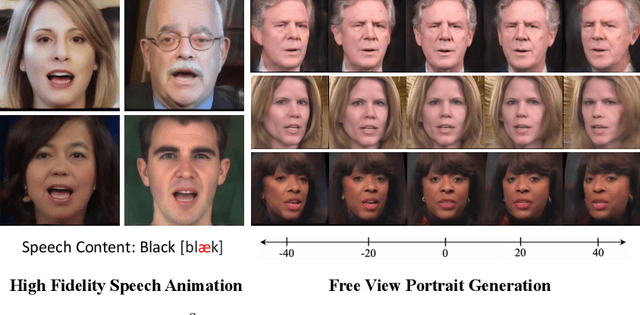
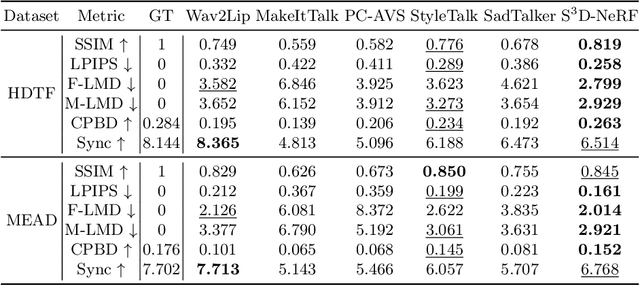
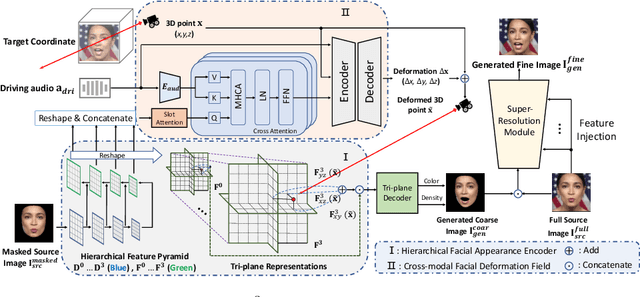
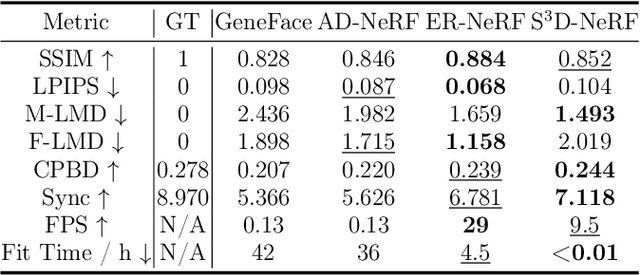
Abstract:Talking head synthesis is a practical technique with wide applications. Current Neural Radiance Field (NeRF) based approaches have shown their superiority on driving one-shot talking heads with videos or signals regressed from audio. However, most of them failed to take the audio as driven information directly, unable to enjoy the flexibility and availability of speech. Since mapping audio signals to face deformation is non-trivial, we design a Single-Shot Speech-Driven Neural Radiance Field (S^3D-NeRF) method in this paper to tackle the following three difficulties: learning a representative appearance feature for each identity, modeling motion of different face regions with audio, and keeping the temporal consistency of the lip area. To this end, we introduce a Hierarchical Facial Appearance Encoder to learn multi-scale representations for catching the appearance of different speakers, and elaborate a Cross-modal Facial Deformation Field to perform speech animation according to the relationship between the audio signal and different face regions. Moreover, to enhance the temporal consistency of the important lip area, we introduce a lip-sync discriminator to penalize the out-of-sync audio-visual sequences. Extensive experiments have shown that our S^3D-NeRF surpasses previous arts on both video fidelity and audio-lip synchronization.
SUBLLM: A Novel Efficient Architecture with Token Sequence Subsampling for LLM
Jun 03, 2024Abstract:While Large Language Models (LLMs) have achieved remarkable success in various fields, the efficiency of training and inference remains a major challenge. To address this issue, we propose SUBLLM, short for Subsampling-Upsampling-Bypass Large Language Model, an innovative architecture that extends the core decoder-only framework by incorporating subsampling, upsampling, and bypass modules. The subsampling modules are responsible for shortening the sequence, while the upsampling modules restore the sequence length, and the bypass modules enhance convergence. In comparison to LLaMA, the proposed SUBLLM exhibits significant enhancements in both training and inference speeds as well as memory usage, while maintaining competitive few-shot performance. During training, SUBLLM increases speeds by 26% and cuts memory by 10GB per GPU. In inference, it boosts speeds by up to 37% and reduces memory by 1GB per GPU. The training and inference speeds can be enhanced by 34% and 52% respectively when the context window is expanded to 8192. We shall release the source code of the proposed architecture in the published version.
Accelerating Transformer Pre-Training with 2:4 Sparsity
Apr 02, 2024Abstract:Training large Transformers is slow, but recent innovations on GPU architecture gives us an advantage. NVIDIA Ampere GPUs can execute a fine-grained 2:4 sparse matrix multiplication twice as fast as its dense equivalent. In the light of this property, we comprehensively investigate the feasibility of accelerating feed-forward networks (FFNs) of Transformers in pre-training. First, we define a "flip rate" to monitor the stability of a 2:4 training process. Utilizing this metric, we suggest two techniques to preserve accuracy: to modify the sparse-refined straight-through estimator by applying the mask decay term on gradients, and to enhance the model's quality by a simple yet effective dense fine-tuning procedure near the end of pre-training. Besides, we devise two effective techniques to practically accelerate training: to calculate transposable 2:4 mask by convolution, and to accelerate gated activation functions by reducing GPU L2 cache miss. Experiments show that a combination of our methods reaches the best performance on multiple Transformers among different 2:4 training methods, while actual acceleration can be observed on different shapes of Transformer block.
 Add to Chrome
Add to Chrome Add to Firefox
Add to Firefox Add to Edge
Add to Edge